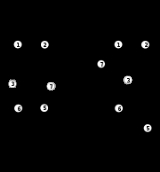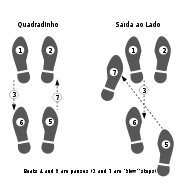
Samba de Gafieira
Encyclopedia
Samba de Gafieira is a partner dance
to the Brazil
ian samba
musical rhythms.
Samba de Gafieira must be distinguished from the ballroom Samba, danced in International Latin and American Rhythm ballroom dance
styles.
Gafieira is usually a pair dance, although in artistic performances it is not uncommon to add solo variations, including steps of Samba no Pé.
. The term gained recognition in 1940s. Over time the style significantly evolved away from the style 1940s under significant influence of Argentine Tango
and incorporating many acrobatic elements."
 Like Argentine Tango, Gafieira is danced in either open embrace, where lead and follow connect at arms length, or close embrace, where the lead and follow connect chest-to-chest.
Like Argentine Tango, Gafieira is danced in either open embrace, where lead and follow connect at arms length, or close embrace, where the lead and follow connect chest-to-chest.
") or Quadradinho) is a simple beginner's step with rhythm "quick-quick-slow" over 4 beat measure.
It is not really a box step, but rather similar to the "Basic movement" of the internaltional ballroom Samba syllabus, and its 8-beat basis step sequence is performed in reverse, with the leader moving his left foot back on three and his right foot forward on seven.
The lateral movements on one and two and on five and six are almost in place (or sometimes on one moving the left foot slightly forward and on five moving the right foot slightly backward).
Often only a half of the passo basico is used, e.g., as part of other, more complicated step patterns.
To execute the figure, start with the first 5 footsteps of the PAsso Basico, with the leader's 5th step taken slightly backwards, slightly parting form the follower. The leader's 6th (slow, right foot) step is forward left across the standing foot outside the partner. The follower's 6th step is backward sideways, crossing the left foot behind.
I descriptions of more complicated patterns, "Saída ao Lado" often refers to only the last three described steps.
Samba de Gafieira is not resricted to the syllabus, which only lists steps commonly agreed to be most important. New steps may be created or entries and exits of the described steps modified, provided they preserve the spirit of Samba de Gafieira.
Partner dance
Partner dances are dances whose basic choreography involves coordinated dancing of two partners, as opposed to individuals dancing alone or individually in a non-coordinated manner, and as opposed to groups of people dancing simultaneously in a coordinated manner.In the year 1023 the German poet...
to the Brazil
Brazil
Brazil , officially the Federative Republic of Brazil , is the largest country in South America. It is the world's fifth largest country, both by geographical area and by population with over 192 million people...
ian samba
Samba
Samba is a Brazilian dance and musical genre originating in Bahia and with its roots in Brazil and Africa via the West African slave trade and African religious traditions. It is recognized around the world as a symbol of Brazil and the Brazilian Carnival...
musical rhythms.
Samba de Gafieira must be distinguished from the ballroom Samba, danced in International Latin and American Rhythm ballroom dance
Ballroom dance
Ballroom dance refers to a set of partner dances, which are enjoyed both socially and competitively around the world. Because of its performance and entertainment aspects, ballroom dance is also widely enjoyed on stage, film, and television....
styles.
Gafieira is usually a pair dance, although in artistic performances it is not uncommon to add solo variations, including steps of Samba no Pé.
Word meaning
The word "Gafieira" can also refer to the traditional samba music orchestra, as well as the dance hall where it is performed. The term gafieira was Brazilian Portuguese slang meaning "low dancing resort, gaff, honky-tonk" or "dance festivity frequented by the populace".Origins
The style originated fom samba dancing in cabarets and gafieiras (hence the name, literally meaning "Samba of gafieira"), primarily in districts of Botafogo, Catete and Centro of Rio de JaneiroRio de Janeiro
Rio de Janeiro , commonly referred to simply as Rio, is the capital city of the State of Rio de Janeiro, the second largest city of Brazil, and the third largest metropolitan area and agglomeration in South America, boasting approximately 6.3 million people within the city proper, making it the 6th...
. The term gained recognition in 1940s. Over time the style significantly evolved away from the style 1940s under significant influence of Argentine Tango
Argentine Tango
Argentine tango is a musical genre of simple quadruple metre and binary musical form, and the social dance that accompanies it. Its lyrics and music are marked by nostalgia, expressed through melodic instruments including the bandoneon. Originated at the ending of the 19th century in the suburbs of...
and incorporating many acrobatic elements."
Beginners' steps

Passo basico
Passo basico ("Basic step", sometimes called Quadrado ("box stepBox Step
Box Step is a basic dance step named after the pattern it creates on the floor, which is that of a square or box. It is used in a number of American Style ballroom dances: Rumba, Waltz, bronze-level Foxtrot. While it can performed individually, it is usually done with a partner. This is the most...
") or Quadradinho) is a simple beginner's step with rhythm "quick-quick-slow" over 4 beat measure.
It is not really a box step, but rather similar to the "Basic movement" of the internaltional ballroom Samba syllabus, and its 8-beat basis step sequence is performed in reverse, with the leader moving his left foot back on three and his right foot forward on seven.
The lateral movements on one and two and on five and six are almost in place (or sometimes on one moving the left foot slightly forward and on five moving the right foot slightly backward).
Often only a half of the passo basico is used, e.g., as part of other, more complicated step patterns.
Saída Lateral
The Saída Lateral or Saída ao lado (both literally mean "exit to side", "lateral exit", sometimes translated as "right cross body lead") step is used to enter or exit many other more elaborate Gafieira steps.To execute the figure, start with the first 5 footsteps of the PAsso Basico, with the leader's 5th step taken slightly backwards, slightly parting form the follower. The leader's 6th (slow, right foot) step is forward left across the standing foot outside the partner. The follower's 6th step is backward sideways, crossing the left foot behind.
I descriptions of more complicated patterns, "Saída ao Lado" often refers to only the last three described steps.
Syllabus
In 2001, a meeting of teachers took place in Rio de Janeiro, where a common syllabus of main steps for Samba de Gafieira was established, for unified teaching and competitions. The voted syllabus excludes acrobatic steps, i.e., the ones where both feet of a dancer are off the ground. It also excluded steps not characteristic to Brazilian dance. The syllabus is divided into three catefories: Nível Básico (Basic Level, or "Bronze"), Nível Intermediário (Intermediate Level, or"Silver"), and Nível Avançado (Advanced Level, or "Gold").Samba de Gafieira is not resricted to the syllabus, which only lists steps commonly agreed to be most important. New steps may be created or entries and exits of the described steps modified, provided they preserve the spirit of Samba de Gafieira.
Nível Básico
- Passo Básico(Basic)
- Saída Lateral (Lateral Parting)
- Tirada ao lado (Lateral Drawing)
- Cruzado (Crossed)
- Gancho (Hook)
- Balanço (Swing)
- Caminhada (Promenade)
- Esse (letter "S")
- Giro da Dama (Lady's Spin)
- Puladinho (Jump)
Nível Intermediário
- Romário (a soccer player name)
- Tirada de Perna (Leg Taken Off)
- Assalto
- Facão (Big Knife)
- Gancho Redondo (Round Hook)
- Trança (Twist)
- Tesoura (Scissors)
- Balão Apagado (Falling Balloon)
- Picadinho (another Twist)
- Mestre Sala
Nível Avançado
- Pião (Top, spinning toy)
- Pica-pau (Woodpecker)
- Escovinha
- Bicicleta (Bike)
- Enceradeira

